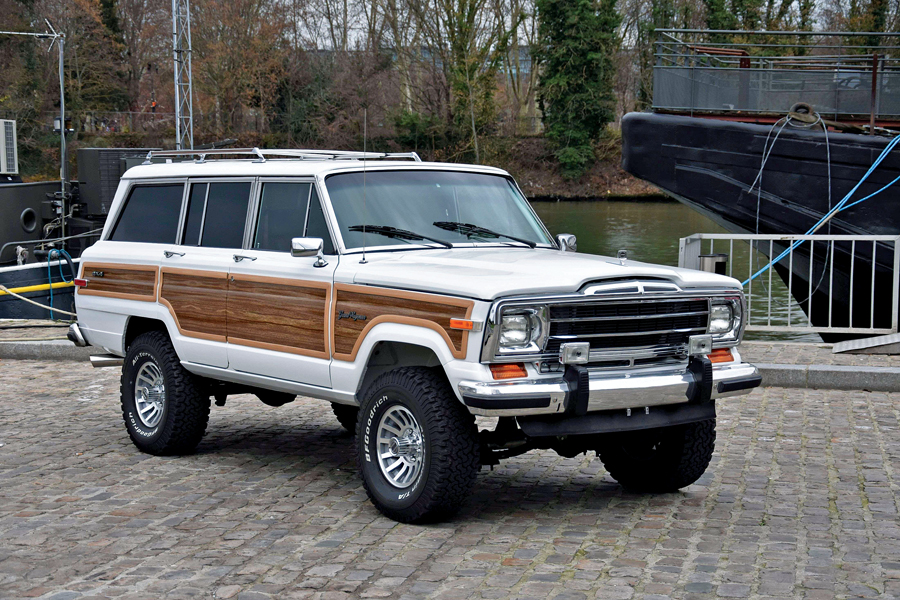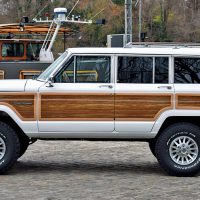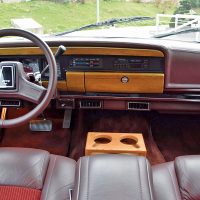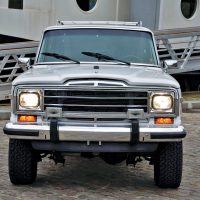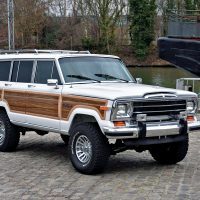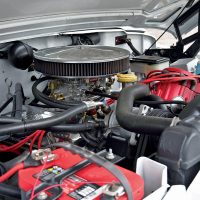- Precursor of today’s SUVs
- Frame-off restoration
- Mythical model, future collector’s car
- 5.9-L V8 and automatic transmission
SCM Analysis
Detailing
| Vehicle: | 1990 Jeep Grand Wagoneer |
| Years Produced: | 1984–91 |
| Number Produced: | 103,298 |
| Original List Price: | $28,455 (1990) |
| SCM Valuation: | $15,500 |
| Tune Up Cost: | $250 |
| Chassis Number Location: | Driver’s side fender apron |
| Engine Number Location: | Front of the block on the passenger’s side — above the oil pan |
| Club Info: | International Full Size Jeep Association |
| Website: | http://www.ifsja.org |
| Alternatives: | 1990 Range Rover Classic, 1990 GMC Suburban, 1990 Toyota Land Cruiser |
| Investment Grade: | C |
This SUV, Lot 84, sold for $55,278 (€48,720), including buyer’s premium, at Artcurial’s Rétromobile auction in Paris, France, on February 8, 2019.
The sale was against a €50k–€70k ($57k–$79k) reserve. It previously sold at Artcurial’s Automobile sur les Champs 14 in November 2018 for $55,532 (€48,640).
I have many fond childhood memories of my mother’s Grand Wagoneer. We called it “the tank.”
The most lurid memory is of my brother sitting out of the front passenger’s window in the Pizza Hut parking lot on Yellowstone Road in Cheyenne, WY. He looked back and then fell down to the pavement. I believe that was his first broken bone, but it certainly wasn’t his last.
I loved this vehicle. It was big, imposing, and never left us stranded in a Wyoming winter storm. Sure, the paint was bad, and the vinyl decals clung to the side with more hope than adhesive. And it was tan. Tan paint, tan leather, tan carpet — like it was sculpted from a sand dune.
Mom kept that rig for years, only to upgrade to a full-size van when the four of us (Ma, me, my brother and my sister) needed a little more separation on regular trips across Nebraska to see the family in Iowa. Laden, unladen — it didn’t matter — the tank did it all at 11 mpg. That helps explain why the model didn’t last too long in the 1990s.
Like a vault
Jeep introduced the Wagoneer for the 1963 model year, replacing the Willys Jeep station wagon. Fast-forward to 1970, when AMC acquired Kaiser Jeep Corp., and the model’s evolution really kicked into gear.
The 360-ci V8 replaced the Buick 350-ci Dauntless V8 in 1971. Other engines came in and dropped out of the line-up throughout the years. Disc brakes became standard equipment in 1974. Boxed frames and stronger crossmembers were in order beginning in 1976. In 1979 AMC added the Limited edition to the model line, and its base price jumped over $10k for the first time, to $12,485. That was just $1,755 cheaper than the Cadillac Eldorado.
AMC divided the Wagoneer line into three versions in 1981 — Custom, Brougham and Limited. This set up the big change in 1984, when the Limited line became the Grand Wagoneer — and the sole vehicle on the SJ platform (the same one it started on in 1963).
Chrysler acquired AMC in March 1987, with an eye on the Jeep lineup. Chrysler didn’t make many updates to the Grand Wagoneer under their ownership until the 1989 models, when they added a rear wiper, upgraded many parts, improved rust protection and started applying the exterior paint in a two-stage process. They added an overhead console — from Chrysler’s minivans — with compass and exterior temperature gauge.
One quick note: If you’re looking at one of these, always check out the door fit. They were built like vaults. The doors should thunkloudly and clearly when giving them a hard close. Any sag or incongruity could be sloppy hinges — they are heavy doors — but all that should go away when they’re closed. If not, you’re probably looking at significant structural issues. Run — don’t walk — the hell out of there.
Speaking of vaults, Chrysler took the public adoration of the Grand Wagoneers to the bank after their purchase of AMC in March 1987. In the October 1987 issue of Popular Mechanics, Jim Dunne quoted an unnamed AMC executive stating that each Grand Wagoneer was profitable by “some five or six thousand” dollars.
No honeymoon lasts forever. In 1990, Grand Wagoneer sales plummeted to 6,810 from 12,345 in 1989, mostly because gas prices shot up 11% thanks to the lead up to the Gulf War. It didn’t help that such an antiquated chassis needed to be re-engineered to meet new safety standards by the mid-’90s. Oh, and there was that whole 11-mpg thing, too.
Not perfect, but just about right
Jeep Heritage of Columbus, TX, restored our subject Grand Wagoneer. According to the catalog, “The body was stripped back to bare metal and all the elements of the car were thus gone over, documented by a photo file and at high costs.”
I was only able to look at catalog and Internet photos, but I did speak with several people who looked at the vehicle in person at Artcurial. It all adds up to very little to fuss about on this particular car.
This Grand Wagoneer is actually featured on Jeep Heritage’s website as an example of their work. Sound deadening is under the carpet. The vinyl “wood” and trim appear in great shape — yep, it’s new. The burgundy leather barely shows wrinkling on the front seats and none at all on the rear. Even the hood ornament is clear and chip-free.
There appears to be a three-inch lift, which is a good thing here. Added clearance adds to functionality (up to a point), but this SUV is not likely to see any serious off-road use.
Then there is under the hood. It’s a mash of original and aftermarket parts: Edelbrock chrome valve covers and 4-bbl carburetor, headers, Optima Red Top battery, bright red plug wires, and that sure appears to be an MSD distributor cap and coil.
Of course, upgrading the 144-hp 360 is a good idea for a 4,499-pound vehicle. There’s no mention anywhere of internal upgrades or a rebuild on the block.
King of the hill
This Grand Wagoneer is the auction market leader. There are no records in the SCM Platinum Auction Database to indicate that any other Grand Wagoneer sold for more than this one did. This makes sense for a 1990 model, as the 1989–91 examples are considered the best of the run.
The next-closest sales were at Bonhams’ 2014 Greenwich auction (1988 model, SCM# 6717159) and Barrett-Jackson’s 2018 Scottsdale extravaganza (1984 model, SCM# 6862961) at $44k each. Even a Final Edition (’91) in the best color (Black Cherry Pearl) with celebrity ownership (Anthony Kiedis, singer of Red Hot Chili Peppers) pulled in $40,700 at Dan Kruse Classics’ Midland 2018 sale (SCM# 6872329).
I don’t see our subject SUV as much of a market mover, however.
It’s top of the heap at auction, certainly, as it sold for nearly the same price both times. It’s a great color combination. There are no worries of blistering clear coat or curling vinyl.
An Artcurial auction in Paris is not the market for all Grand Wagoneers. This sale won’t bring babied, low-mileage Grand Wagoneers out of rural garages and onto the auction block. I think that’s more likely after the first $100k-plus sale at auction.
There are Grand Wagoneers offered for sale at any given time — often at prices higher than the buyer paid here. Jeep Heritage’s website says you can start building yours for $95k if you have the base rig, or $105k if you want them to supply it. That also gives us some sense of the build cost for this one.
This is a very nice rig. I’d love to drive it from SCM World Headquarters in Portland, OR, all the way back to Wyoming. I’ll pass on the road to Iowa.
Well bought and fairly sold. ♦
(Introductory description courtesy of Artcurial.)
